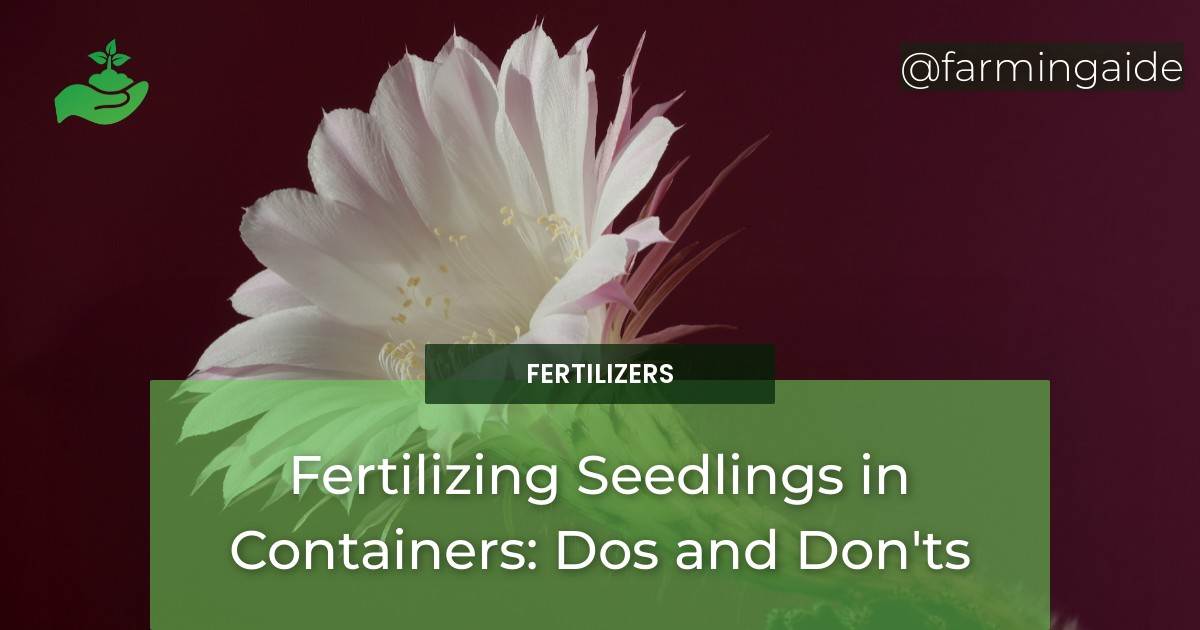Container gardening has become increasingly popular in recent years, as it allows for the cultivation of plants in limited space. Fertilizing seedlings is crucial to ensure they receive the necessary nutrients for healthy growth. However, it requires knowledge of the proper techniques and timing. In this article, we will discuss the dos and don’ts of fertilizing seedlings in containers. We will cover when to start fertilizing seedlings, proper fertilization techniques, common mistakes to avoid, and more. By the end of this article, you will have comprehensive knowledge of seedling care, nutrient requirements, and the best practices for fertilizing seedlings in containers, which will help you avoid common pitfalls and grow healthy plants.
When to Start Fertilizing Seedlings
Timing is crucial when it comes to fertilizing seedlings. Starting too early or too late can have adverse effects on their growth.
Importance of Timing
Seedlings have different nutrient requirements at different stages of growth. Fertilizing too early can lead to the accumulation of excess nutrients, which can damage the delicate root systems of the seedlings. On the other hand, fertilizing too late can result in nutrient deficiencies, which can stunt the growth of the seedlings.
Factors Affecting the Timing
Several factors can affect the timing of fertilization, including the type of plant, the size of the container, and the type of soil used.
Signs Seedlings Need Fertilization
Seedlings may show signs of nutrient deficiencies, indicating the need for fertilization. These signs include stunted growth, yellowing leaves, and wilting.
Proper Fertilization Techniques for Seedlings
Choosing the right fertilizer and applying it correctly are essential for the healthy growth of seedlings.
Choosing the Right Fertilizer
Seedlings have specific nutrient requirements, and it is crucial to choose a fertilizer that meets these requirements. Look for a fertilizer with a balanced ratio of nitrogen, phosphorus, and potassium.
Mixing Fertilizer with Water
Diluting the fertilizer with water is necessary to avoid over-fertilization. Mix the fertilizer according to the manufacturer’s instructions and use a watering can or sprayer to apply it to the soil.
Applying Fertilizer to Seedlings
Avoid pouring the fertilizer directly onto the seedlings as it can damage the delicate leaves. Instead, apply the fertilizer to the soil around the base of the seedlings.
ALSO READ
Common Mistakes to Avoid
Several common mistakes can lead to over or under-fertilization, using the wrong type of fertilizer, and damaging the seedlings.
Over-Fertilization
- Using too much fertilizer can lead to the accumulation of excess nutrients in the soil, which can damage the roots of the seedlings.
- Signs of over-fertilization include burned leaves, wilting, and stunted growth.
Under-Fertilization
- Seedlings may not grow to their full potential without sufficient nutrients.
- Signs of under-fertilization include yellowing leaves, slow growth, and small leaves.
Using the Wrong Type of Fertilizer
- Using the wrong type of fertilizer can lead to nutrient imbalances and damage the seedlings.
- Choose a fertilizer with a balanced ratio of nitrogen, phosphorus, and potassium.
Failing to Water Seedlings After Fertilization
- Watering the seedlings after fertilization is essential to help the fertilizer reach the roots.
- Avoid overwatering, as this can lead to nutrient leaching and root rot.
What Are the Best Fertilizing Practices for Seedlings in Containers?
When fertilizing seedlings in containers, choosing the right trowel can make a difference. Opt for a small, handheld trowel to easily distribute fertilizer around the base of the seedlings without causing damage. Use a balanced fertilizer to support healthy growth and apply it sparingly to avoid overfeeding.
Conclusion
Fertilizing seedlings in containers can be challenging, but with the right techniques and timing, it can be a rewarding experience. Remember to choose the right type of fertilizer, mix it with water, and apply it correctly. Avoid common mistakes such as over or under-fertilization and using the wrong type of fertilizer. By following these dos and don’ts, you can ensure the healthy growth of your seedlings and the success of your container garden.
RELATED ARTICLES:


